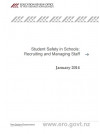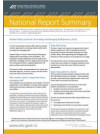This report presents the findings of ERO's 2013 evaluation of how schools ensure student safety when recruiting and managing staff.
Purpose
This report presents the findings of an evaluation of schools’ approaches to ensuring student safety when recruiting and managing staff. The evaluation was undertaken in response to a request by the State Services Commission and the Ministry of Education (Ministry) after recent inquiries into the employment of sex offenders in New Zealand schools.
Methodology
The overarching question ERO sought to answer was ‘How well do schools ensure student safety when recruiting and managing staff?’ This was explored through five questions with their own set of ratings and indicators.
- How effectively does the school balance the needs of students and staff when dealing with concerns about staff?
- How appropriate are the school’s recruitment and appointment processes?
- How robust are the checks carried out by the school? (for example, a wide range of checks on suitability for working with students)
- How robust are the attestation and registration processes?
- How well prepared and knowledgeable are boards and principals for their role as employer?
Information for this report was drawn from four sources:
- an online survey of a sample of board chairpersons who had appointed a principal in 2011-2012 (148 chairpersons, 68 percent response rate)
- an online survey of a random sample of principals about appointing staff and student safety (199 principals, 67 percent response rate)
- an investigation into performance management practices in 27 selected secondary schools in Term 1, 2013
- an investigation into performance management practices in 173 primary schools in Term 1, 2013.
The online surveys gathered detailed information from schools about their documented policies and procedures, sources of information and advice, recent appointments, involvement of other people, reference checking, and confidence in making appointments.
Boards were also asked about their background and experience. Principals answered questions about policies and procedures for managing staff issues while ensuring student safety, and actions taken to support student wellbeing.
The demographic characteristics of responding schools were generally similar to those of all schools nationally. The few differences that were statistically significant are described in Appendix 2.
Appendix 3 and Appendix 4 present the survey questions and responses of board chairpersons and principals.
Investigations in schools
The investigations in primary and secondary schools enabled reviewers to interview trustees and staff and review documentation so that they could make judgements in relation to the key evaluative questions. Appendix 5 shows the indicators for each evaluative question.
Safety and appointments in 173 primary schools were evaluated as part of their regular education reviews. The investigations did not include any schools with an early return of one-to-two years signalled in their previous ERO review report or any schools where the previous ERO review stated that their next review would be within four-to-five years because these schools were not due for a review in 2013.
As only a few secondary schools were scheduled for review in Term 1, a sample of 27 secondary schools was selected for an onsite investigation by an ERO team who visited solely to review employment responsibilities. Analysis of the most recent ERO review report of these 27 schools showed that their overall performance tended to be more effective than secondary schools overall. The previous review reports of these secondary schools visited had signalled a return after four-to-five years for one-third compared with 15 percent nationally. It is therefore probable that the secondary schools visited are more effective than all secondary schools nationally, and the secondary school figures presented in this report give a more positive picture than would be true for all schools.
Key Results
This report affirms the findings from recent reports and investigations into the employment of sex offenders in schools. The Ministerial Inquiry into the Employment of a Convicted Sex Offender in the Education Sector (Ministerial Inquiry) and the Report to the Commissioner of Pamapuria School on Review of the Employment and Offences of James Parker (Parker Report) identified how important it is for schools to design, manage and administer employment practices to provide the utmost protection for students in their school and wider community.
ERO’s evaluation found that two-thirds of schools had robust practices to ensure student safety when appointing and managing staff. In the schools with very robust practices they:
- proactively developed a coherent and connected focus on student safety across all procedures, with policies containing enough detail to guide actions
- were vigilant so practices followed policies and procedures and were reviewed in a timely and reflective manner
- robustly checked potential employees’ backgrounds, experience, qualifications and identities
- consistently accessed and used the resources that were available to guide decisions about employing and managing staff.
Schools that ERO has judged to be high performing in other aspects were more likely to have made student safety paramount and have robust procedures and practices to support this.
One-third of the schools reviewed had practices that meant they were unlikely to recognise situations when students are at risk from some staff and respond appropriately. In these schools little attention had been paid to the recent lessons learnt in other communities in New Zealand. Boards and leaders need to acknowledge that unless they develop, manage and administer more robust employment systems, students in their school or community could be harmed in the future.


